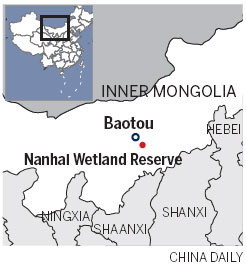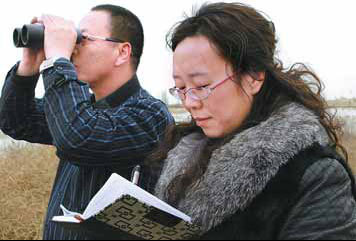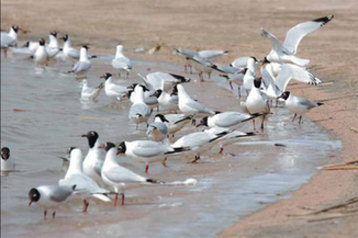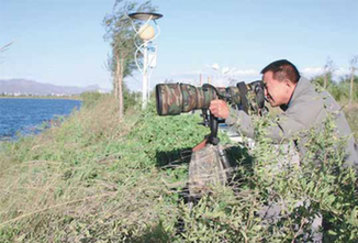Wetlands a world for birds
Updated: 2013-05-07 08:12
By Wang Kaihao (China Daily)
|
||||||||
|
Miao Chunlin (right), head of the protection station of the Nanhai Wetland Reserve, gathers bird migration data. Provided to China Daily |
|
Relict Gulls, a rare migratory species visiting Nanhai Wetland Reserve, close to the center of Baotou city in the Inner Mongolia autonomous region. Chen Xuegu / for China Daily |
|
Chen Xuegu, a photographer at Nanhai reserve snaps flocks of migratory birds at the wetland. Provided to China Daily |
Protectors work hard to save their fluffy friends, reports Wang Kaihao in Baotou, Inner Mongolia autonomous region.
For Chen Xuegu, 51, the Nanhai wetland is almost his entire world.
Since the first whooper swan landed on the waters alongside the Yellow River in late January, Chen has been working hard. Every morning, he rises before daybreak to take photos of flocks of migratory birds.
"My mother often calls and tells me to keep away from the birds," he smiled. "She's scared of the H7N9 flu. Well, it's our honor to have these flying guests coming up from the south. I have no reason to keep away from them."
Nevertheless, he recently bought a new pair of rubber boots in case he inadvertently steps in bird droppings. As the only full-time photographer at the Nanhai Wetland Reserve, covering almost 1,600 hectares in Baotou, the Inner Mongolia autonomous region, he also monitors the condition of the local fauna and looks for dead birds.
Apart from two years in the People's Liberation Army, Chen has spent his life around the wetlands and calls himself a Wetlander. Born into a fishing family, he grew up watching all kinds of waterfowl. As a child, he often joined friends to trap birds for food, and, he admits, for fun, but he is pleased times have changed.
Nanhai is an important link in a wetland chain along the Yellow River, a crucial route for various species of migratory birds heading to Siberia from China's southernmost provinces.
The reserve has a patrol team of eight at its wetland protection station. According to the head, Miao Chunlin, the frequency of daily patrols has recently risen. Miao's squad undertakes two-hour patrols at least twice a day. The frequency is increased whenever the schedule allows.
Observation towers provide an overview of the area. The station began daily patrols in 2007, and keeps a detailed record. Despite the recent outbreak of bird flu, no unusual deaths have been discovered.
The National Forestry Bureau released an urgent statement in early April, ordering nature reserves at all levels to intensify the supervision of migratory birds to allay a possible spread of H7N9. However, although bird droppings are suspected to contain the virus, so far, tests have not provided any concrete evidence.
In mid-April, the National Forestry Bureau sent a team to Ulansuhai Nur, in Bayannur city, also along the Yellow River, to collect 120 samples of Mute Swan droppings to see if any contained the virus. No positive results have yet been reported.
However, despite being situated closer to Baotou's densely populated areas, Nanhai was unable to take equally stringent action. According to Bao Jiaoqi, the director of the wetland protection center at Baotou's municipal forestry bureau, any wild birds that die of disease are immediately sent for examination, but the measure is not a response to H7N9.
Baotou has not tested bird droppings because the tests can only be conducted at national-level laboratories, which are currently focusing more on China's national-level natural reserves, according to Bao.
"There is no confirmed link between wild migratory birds and H7N9, based on our observations," said Yang Guisheng, professor of ornithology at the Inner Mongolia University. "However, further studies are ongoing, but we can't really check to see if all migratory birds are safe because their numbers are huge."
For now, Nanhai's patrol teams can only warn tourists and local residents to keep away from the birds. Miao said the staff remain optimistic in the face of H7N9, especially after the area was the scene of a crisis almost a decade ago.
Catastrophe
In 2004, a China Eastern Airlines plane crashed into the lake shortly after takeoff from Baotou airport, causing the deaths of 55 people. The accident also spelled an environmental catastrophe for Nanhai; leaked engine oil resulted in the quality of the water plunging below category V, the most severe pollution level.
"The planes soon resumed flying overhead, but the devastated waters were left. We were close to the end of our world," Miao recalled.
Yu Wei remembers the incident, which happened less than 12 months after he took over as director of the reserve's management committee.
"People gathered to search for victims, but few cared about the water and the birds, both of which were greatly harmed."
With a grant of nearly 300 million yuan ($48.7 million) from the municipal government, and compensation of 33 million yuan from China Eastern Airlines, the park endeavored to recover the ecosystem. Clean water was fed into the most polluted part of the lake - roughly 10,000 square meters - and new, non-polluted mud was added. Meanwhile, spiral shells, waterweeds and mud-dwelling creatures were introduced to replenish the environment. The park reopened in 2007.
In 2008, Inner Mongolia passed the Nanhai Wetland Natural Reserve Protection Rule, the region's only law designed to supervise a specific nature reserve.
"The legal system is the most important aspect. Some work can only be processed through laws," said Yu. "The province-level rules can offer guidance for the work in general, but our own rules are more pragmatic."
The quality of water has regained its category III status and the variety of bird species is now more abundant than before the accident. Only 77 species were discovered in 1992, but the number has now reached 201, although Miao concedes this could be due to more-stringent observations.
"If not for the plane crash, people might not have paid any attention to protecting this wetland," said Miao. "However, once things returned to normal, it again became difficult to attract attention. We are like monks begging for meals, just to get more funding."
Funding conundrum
Funding is a big problem for Nanhai, whose annual revenue is in excess of 7 million yuan. Half of that sum is spent on wetland protection, which leaves little cash available for new projects, let alone expensive testing equipment for the labs.
The team moved into a two-story office in 2011. The second floor houses a photo gallery of birds along the Yellow River. As Miao explained, the popular science angle is crucial to the wetland's survival: "If we don't let the public know what we are protecting, why should they pay attention to us?"
Gasoline is in limited supply, so the teams patrol the wetlands on bicycles, and the computers in the office don't even have access to the Internet.
However, the biggest problem is a dispute with local residents concerning 200 hectares of land. Although villagers don't live inside the boundaries of the reserve, some of the land includes fields that have been cultivated by locals for generations.
"When we asked the villagers to return the land and leave more room for the birds, they argued that the constitution promises them the right to live, and they can't live without the land," said Yu, who formerly worked at the municipal law office.
"Cultivating this land is difficult because it's often flooded, but we understand the ancient agricultural traditions that make farmers reluctant to leave their homeland.
"The only solution is to compensate the villagers, which may cost tens of millions of yuan. Do you think that's possible in our position?" he asked.
A hub for Relict Gulls
The Relict Gull, an endangered migratory species, only nests on sandy islands in the middle of lakes. It's estimated that there are only 16,000 of these birds worldwide, and approximately 60 percent of them inhabit the nearby Ordos Plateau. However, the area of Hongjian Nur, one of their major hubs, is shrinking because of a decrease in precipitation and an increase in water use in the surrounding urban areas. The lake covered 32.88 square kilometers in 2012, a drop of 50 percent in 20 years.
Relict Gulls were first seen in Nanhai in 2008 and roughly 5,000 arrived at the lake in 2010.
In 2012, ornithologist Liu Li arrived at Nanhai to study the gulls. Having spent five years at the Tokyo University of Agriculture and Technology, the Inner Mongolia native said wetland protection is more needed at home than in Japan.
"Relict Gulls could find a substitute nesting place here, but we must create similar circumstances to their previous habitats," he said, although he added that there have not been enough relevant studies to pinpoint specific migratory routes and living habits.
Baotou began a three-year-long Yellow River wetlands restoration project in 2011, reclaiming 133 hectares of wetland for Nanhai. The project involved building a number of islands in the middle of the lake. The protection station was given 100,000 yuan by the municipal government to buy the sand needed to build the islands, but although more than 1,000 gulls have nested on these islands, so far Relict Gulls have not been among them.
"Maybe we need to beg for more money to keep transforming the living environment?" said Miao. "Or maybe, they just won't come at all."
Adding to the problems, a cargo route bisects the wetlands. Although the road, first built in the 1990s, has not been upgraded to an asphalt surface, the noise has made the area close to the road a forbidden zone for birds.
"As the road was built before the promulgation of the reserve regulation, it is difficult to shut it down," said Yu.
"Nanhai is probably the last place belonging to nature in downtown Baotou," he said. "We can only try our best within our capacity and pray some Relict Gulls nest here. If so, it would be of great benefit for the wetland. It would help us to persuade higher-level decision makers to move the road."
Contact the writer at wangkaihao@chinadaily.com.cn

(China Daily 05/07/2013 page6)

 Michelle lays roses at site along Berlin Wall
Michelle lays roses at site along Berlin Wall
 Historic space lecture in Tiangong-1 commences
Historic space lecture in Tiangong-1 commences
 'Sopranos' Star James Gandolfini dead at 51
'Sopranos' Star James Gandolfini dead at 51
 UN: Number of refugees hits 18-year high
UN: Number of refugees hits 18-year high
 Slide: Jet exercises from aircraft carrier
Slide: Jet exercises from aircraft carrier
 Talks establish fishery hotline
Talks establish fishery hotline
 Foreign buyers eye Chinese drones
Foreign buyers eye Chinese drones
 UN chief hails China's peacekeepers
UN chief hails China's peacekeepers
Most Viewed
Editor's Picks

|

|

|

|

|

|
Today's Top News
Shenzhou X astronaut gives lecture today
US told to reassess duties on Chinese paper
Chinese seek greater share of satellite market
Russia rejects Obama's nuke cut proposal
US immigration bill sees Senate breakthrough
Brazilian cities revoke fare hikes
Moody's warns on China's local govt debt
Air quality in major cities drops in May
US Weekly

|

|










